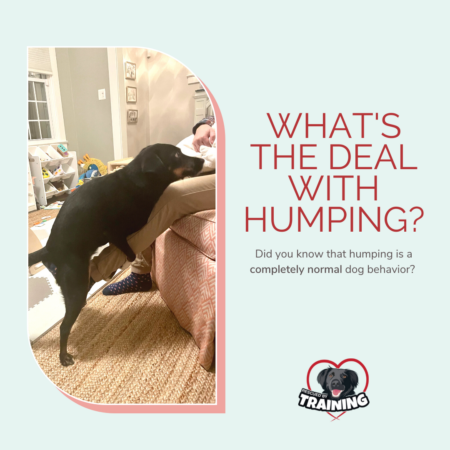Did you know that humping is completely normal dog behavior? While it is often one of the most common things that gets owners worked up and embarrassed (I’m assuming that stems from our aversion to discussing sex in open ways, but that’s another topic!), we should recognize that it is completely normal, species appropriate behavior. Owners often express a need to stop this “inappropriate” behavior, as if their dog humping reflects poorly on them as owners. This is a common issue at dog parks where dogs are excited and playful and hump. Owners freak out thinking their dog is being rude. But that’s not the case.
Humping is a fixed action pattern (FAP), which are “pre-installed” behaviors. These are behaviors that are common to all members of a species and require no learning. We lump FAPs into 4 categories: fight, flight, feeding and reproduction. And as my mentor Jean Donaldson says in her book, Oh, Behave,
“Reproductive behavior is, evolutionarily speaking, the most important. Any animal that lacks super-duper strong courtship and reproductive FAPs doesn’t pass on their genes.”
And dogs don’t seem picky about who or what they hump in many cases. Dogs will hump people, other dogs, other animals, like cats or inanimate objects, like pillows.
So let’s dive in a little bit!
Humping is NOT:
- Dominance
- Controlling you
- Alpha behavior
- Only seen in unfixed animals
- Only seen in males
Humping can be:
- Excitement (like my client Rudy, seen below)
- Sexual rehearsal/masterbation
- Burning off pent up energy
- General stimulation “hey something’s happening!”
- Stress/Anxiety/Displacement behavior
- Attention-getting behavior
- Play
My own dog, Barbo humps our other dog, BooBoo, when he’s excited.Usually this pops out in the backseat of our car when we pull into the garage after being out with them. In that context he seems happy to be home and as we’re getting out of gathering our stuff, he air humps Boo. She rarely even notices because he’s not very good at it. At 13-1/2 I’m happy to see him still have it in him to want to do that!
What can you do about it?
First, try to pay attention to when your dog’s humping happens. Keep a log of data to help. You can also train an alternate, incompatible behavior like a recall, touch or other redirection cue to ask your dog to do another behavior but it’s important to not punish, yell or otherwise try to scare your dog into stopping. This is especially important if your dog humping is anxiety related.
Once you track your data, then you can figure out what your dog’s underlying humping cause is and address it. And hopefully in the process, you can come to acknowledge (and maybe teach others!) that humping is normal and nothing to be embarrassed by.
I normally just let it happen but I’ve known clients to give their dog a designated humping pillow and redirect the dog onto that object if they preferred the dog to not hump their throw pillows or their leg.
If in your data tracking you notice humping popping out as a displacement behavior or in the context of anxiety, then that needs to be addressed to help the dog be less anxious. As with everything, we don’t just focus on the outward symptom, we need to dig deeper and look to treat the root cause of the issue. Remember, behavior suppression isn’t behavior modification.
If you need help, be sure to grab your one on one session with me here!
And, be sure to sign up for my free weekly newsletter so you don’t miss out on free tips, videos, personal stories, client successes and more!
Happy training!
![]()




